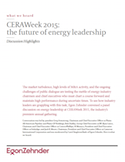What we heard - CERAWeek 2015: “The Future of Energy Leadership” panel discussion
The market turbulence, high levels of M&A activity, and the ongoing challenges of public dialogue are testing the mettle of energy industry chairmen and chief executives who must chart a course forward and maintain high performance during uncertain times. To see how industry leaders are grappling with this task, Egon Zehnder convened a panel discussion on energy leadership at CERAWeek 2015, the industry’s premiere annual gathering. Here is what we heard:
Living with a new level of complexity
It’s “and,” not “either/or.” As the industry girds for a long-term path to recovery, company leaders must balance an array of sometimes contradictory forces: Attack costs and reaffirm a commitment to environment, health and safety that goes beyond compliance. Focus on margins and plan for the future. Investor and stakeholder expectations continue to rise, irrespective of the direction of revenue. Industry leaders are responding to these demands by embracing efficiency, engaging the supply chain, leveraging innovation and improving decision making.
Preparedness pays off: One CEO described how he and his board had developed different strategic plans for various scenarios — including a precipitous drop in oil prices due to heightened production. Another CEO talked about how his firm’s commitment to running lean, even in good times, has given his firm a much appreciated level of balance-sheet flexibility, now that times are tough.
Complexity demands new competencies. Because of the ambiguity of the current environment, chairmen and CEOs are doubling down on communication — with employees, the board, shareholders, regulators and the public. The push for new solutions and greater globalization demands moving past the transactional to relationship-based business, putting a premium on the ability to collaborate and form partnerships across business lines, in joint ventures and with customers. Continualy uncertainty makes resilience a core attribute of current and future leaders. The need for innovation calls for insight beyond experience and technical proficiency.
Talent is everything
The industry has learned from the consequences of earlier hiring droughts that the effort put into finding and developing talent must transcend market fluctuations. Industry executives have also learned from watching Silicon Valley, which is relentless in its hiring of people who can make an impact and grow to become leaders. The insights panelists shared included:
Hire for talent, not for position. Companies are recruiting and hiring talent even when there isn’t an opening available, confident that building human capital will pay off later. That strategy reaches down to undergraduates, for whom companies are keeping internships and college hires at pre-downturn levels.
Follow through with development. Recruiting very talented people is only the first step; even natural-born leaders need help to reach their potential. Inculcate flexibility and a strategic perspective by rotating new hires through different roles and departments. And as the saying goes, never let a crisis go to waste. The large pool of talent that is experiencing their first downturn needs to understand that volatility is part of the business: No one (and no company) gets a pass to underperform because times are tough.
Use compensation aggressively. There is a shift from long-term incentives to up-front equity to cement commitment and make poaching talent expensive.
Cast a wider net. Because of its distinctive culture, the oil industry has historically been reluctant to look beyond its confines for talent. Given the variety of challenges the industry now faces, companies have begun recruiting from elsewhere, particularly for functions such as marketing and EHS that are well-positioned to incorporate best practices from other industries.
Strong Leadership is Critical – what does that mean?
Communicate – to shareholders and stakeholders. Communicate the vision – employees want to feel part of something important and want to win.
Be transparent – don’t communicate uncertainty but be clear about what is known and what is a belief. Be committed but always have the transparency to be flexible. Always ensure that there are credible and viable alternatives that are well known and articulated.
Live the values every day – and ensure that your leaders are aligned behind those and are also demonstrating them consistently.
Nurture your high potentials – challenge board members and executives to make sure they know who are the true high potentials.
Make things happen – through people. Give direction and motivation – and give room to perform.






